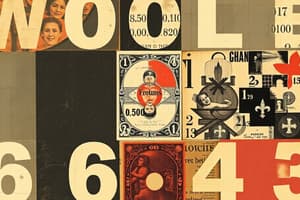Podcast
Questions and Answers
What is the highest common factor (HCF) of 12 and 18?
What is the highest common factor (HCF) of 12 and 18?
- 12
- 3
- 2
- 6 (correct)
The lowest common multiple (LCM) of two numbers is always greater than or equal to the larger of the two numbers.
The lowest common multiple (LCM) of two numbers is always greater than or equal to the larger of the two numbers.
True (A)
What is the prime factorization of 30?
What is the prime factorization of 30?
2 x 3 x 5
The number 1 is not considered a ______ number.
The number 1 is not considered a ______ number.
Match the following terms with their definitions:
Match the following terms with their definitions:
Which of the following is a prime number?
Which of the following is a prime number?
Find the HCF of 24 and 36 using the Euclidean algorithm.
Find the HCF of 24 and 36 using the Euclidean algorithm.
The Sieve of Eratosthenes is a method used to identify prime numbers.
The Sieve of Eratosthenes is a method used to identify prime numbers.
Flashcards
Whole Numbers
Whole Numbers
The set of non-negative integers including zero and positive integers.
Highest Common Factor (HCF)
Highest Common Factor (HCF)
The largest positive integer that is a factor of two or more given numbers.
Finding HCF
Finding HCF
To find HCF, identify common factors and select the largest one.
Lowest Common Multiple (LCM)
Lowest Common Multiple (LCM)
Signup and view all the flashcards
Finding LCM
Finding LCM
Signup and view all the flashcards
Relationship between LCM and HCF
Relationship between LCM and HCF
Signup and view all the flashcards
Prime Numbers
Prime Numbers
Signup and view all the flashcards
Identifying Prime Numbers
Identifying Prime Numbers
Signup and view all the flashcards
Study Notes
Whole Numbers
- Whole numbers are the set of non-negative integers, including zero and all positive integers.
- They are used for counting and measuring discrete quantities.
- Examples: 0, 1, 2, 3, 4,...
- They are a subset of the integers.
Highest Common Factor (HCF)
- The highest common factor (HCF) of two or more numbers is the largest positive integer that is a factor of all the given numbers.
- It is also known as the greatest common divisor (GCD).
- Finding the HCF involves identifying the common factors of the numbers and selecting the largest one.
- Methods for finding the HCF include:
- Listing the factors of each number and identifying the common factors.
- Using prime factorization: finding the prime factorization of each number and identifying the common prime factors raised to the lowest power.
- Using the Euclidean algorithm: a step-by-step process to find the HCF by repeatedly dividing the larger number by the smaller number and replacing the larger number with the remainder until the remainder is zero. The HCF is the last non-zero remainder.
Lowest Common Multiple (LCM)
- The lowest common multiple (LCM) of two or more numbers is the smallest positive integer that is a multiple of all the given numbers.
- Finding the LCM involves identifying the multiples of each number and selecting the smallest common multiple.
- Methods for finding the LCM include:
- Listing multiples of each number and identifying the common multiples.
- Using prime factorization: finding the prime factorization of each number and identifying the prime factors raised to the highest power present in any factorization. Multiplying those factors together gives the LCM.
- Relationship with HCF: The product of two numbers is equal to the product of their LCM and HCF. In other words, (LCM(a, b)) * (HCF(a, b)) = a * b
Prime Numbers
- A prime number is a whole number greater than 1 that has only two factors: 1 and itself.
- Prime numbers are fundamental building blocks of all other whole numbers.
- Examples: 2, 3, 5, 7, 11, 13, 17, 19,...
- 1 is not considered a prime number.
- 2 is the only even prime number.
- Prime numbers can be identified using the Sieve of Eratosthenes. This method systematically eliminates multiples of prime numbers to identify primes within a given range.
- Determining if a number is prime can be done by checking for divisibility by smaller prime numbers up to the square root of the number. If no prime divisor is found, the number is prime.
- Prime factorization is the process of expressing a composite number as a product of its prime factors. For example, 12 = 2 x 2 x 3.
Studying That Suits You
Use AI to generate personalized quizzes and flashcards to suit your learning preferences.




